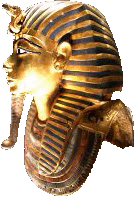| |
| Cairo |
|
| Cairo, the Jewel of the Orient, the City of the Thousand Minarets, and the Melting Pot of Ancient and Modern Egyptian Civilizations
|
| |
|
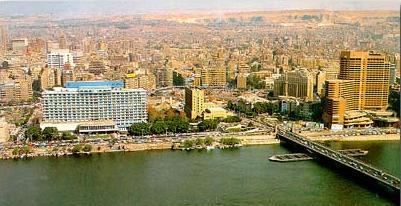
|
| |
|
|
Cairo - the Triumphant City - is the glorious capital of Egypt, the cradle of civilization and the beacon of religion. It is the largest city in the Middle East and Africa and lies at the center of all routes leading to, and from the three continents: Asia, Africa, and Europe. |
| |
|
|
Indeed, a journey through Cairo is a journey through time, a journey through the history of an immortal civilization. |
|
|
No matter how many times you visit Cairo, it will never seem enough. “Humanity” is its basic feature, no matter how chaotic, noisy, and unpredictable it may seem to some. But despite shortcomings, Cairo does still retain the qualities of the “Mother of the World” and a visit to Cairo is rather a life defining experience, that either leaves you provoked or “in love”, but can never leave you indifferent. |
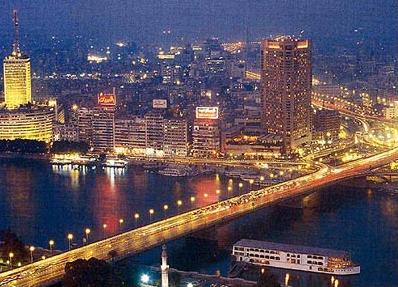
|
|
|
|
A history of four and half thousand years has left their marks on this city and the people, where technology and monuments exist side by side. It’s possible to move from the medieval to Islamic Cairo to the Pharaonic monuments at the Museum and then take your lunch in a French Restaurant without having to move out of Cairo.
|
|
|
|

|
|
|
| Giza |
|
|
Giza, the capital of Giza Governorate, forms a unique suburb of Cairo on the western bank of the River Nile. Together with Qalubeyya Governorate, and the eastern and southeastern parts of Cairo, the three parts are known as greater Cairo. |
|
|
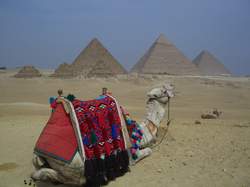
|
Stretching 18 km westwards from the Nile to the Pyramids. Giza covers some 4,700 square kilometers and is the third largest city in Egypt.
It contains the largest number of pyramids-thirty in all; including the three great Pyramids, one of the seven wonders of the ancient world, as well as the great Sphinx |
|
|
|
Giza also holds the site of Egypt’s first capital, Memphis. While not being the capital, Giza is home to most foreign embassies and government offices. Moreover, it has many luxurious apartment buildings along the Nile, making it a preferred residential area. |

|
|
|
|
All in all it is a vibrant city and an administrative, cultural, and commercial center. Cairo University, one of the Middle East’s most prominent universities, happens to be one of Giza’s landmarks. It was founded in 1908 and moved to its current location in 1924 |
|
|
|
A number of major museums can also be found in Giza, such as the Zoological Museum, Botanical Museum, Museum of Modern Art, Mahmoud Mokhtar Museum and Muhammad Mahmoud Khalil Museum. Additionally Giza is home to one of the biggest and oldest zoos in the Middle East and the first media production city to be built in Egypt and the Middle East.
|
|
|
|

|
|
|
| Alexandria |
|
|
|

|
|
|
|
Known as “The Pearl of the Mediterranean”, Alexandria as the second largest city in Egypt has an atmosphere that is more Mediterranean than Middle Eastern, its ambiance and cultural heritage distance it from the rest of the country although it is only 225 km. from Cairo.
|
|
|
|
Alexandria has, for long, been considered Egypt’s best nearby summer resort. Easily getting to the great city after a two-hour drive, Alexandria is the perfect place to get away and relax |
|
|
|
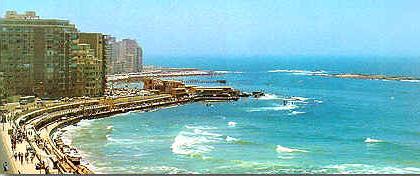
|
|
|
|
Founded by Alexander the Great in 331 B.C., Alexandria became the capital of Greco-Roman Egypt, and its status as a beacon of culture is symbolized by Pharos, the legendry lighthouse that was one of the Seven Wonders of the World. Alexandria was also the center of learning in the ancient world, and has witnessed the stormy relationship between Queen Cleopatra and Mark Antony |
|
|
|
Montazah, located along the coast about 15 miles east of Alexandria’s old district along the Corniche, is where many of the modern Alexandrian hotels are located, as well as one of the elegant heritage hotels. Khedive Abbas II built the Salamlik as a residence. Here also is the magnificent Montazah Palace.
|
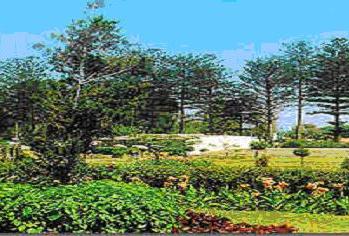
|
|
|
|
There are many sites in Alexandria to visit such as: The Roman Theatre, the Greco Roman museum, Pompey’s Pillar, Catacombs of Kom El Shokafa, Qaitbay Fort, the Royal Jewelry Museum and the Shatby Tombs.
|
|
|
|

|
|
|
| Hurghada |
|
|
|

|
Hurghada was founded in the early 20th century, and until a few years ago, remained a small fishing village. But today, it has gone on to become the foremost tourist resort of the Red Sea coast and an international center for aquatic sports. If it takes place in or on the water you can do it here: windsurfing, sailing, deep-sea fishing, swimming, but, above all, snorkeling and diving |
|
|
|
The unique underwater gardens offshore are some of the finest in the world, justifiably famous amongst divers. The warm waters here are ideal for many varieties of rare fish and coral reefs, which may also be observed through glass bottom boats. This area has many fine accommodations, usually offering warm and efficient service. Restaurants are mostly along the main road. While in Hurghada, don't miss the museum and aquarium, with their complete collections of flora and fauna of the Red Sea.
|
| |
|
|
Besides diving, Hurghada, with its perfect weather all year round, is also an international centre for water sports: swimming, sailing, water-skiing, and windsurfing. Other than water sports, hotels and resorts offer a full complement of sports activities, from tennis and squash to beach volleyball and basketball. Hurghada is also home to the International Hurghada Squash Championship, hosting the top squash players in the world |
| |
|
|
To get a more intimate feel of the beauty of the desert, go on a safari by four wheel drive vehicles or by camels and camp overnight in the heart of the majestic Red Sea mountains With guaranteed sunshine all year, golden sandy beaches, and warm turquoise water, Hurghada is an ideal place for travelers wishing to unwind and recharge their batteries
Hurghada is serviced by regular flights to and from Cairo and is accessible by a 528 km road journey Via Suez. A good road connects Hurghada with Luxor. This 280 km journey takes about four hours and combines the spectacular scenery of the eastern desert with the lush rural setting of the Nile.
|
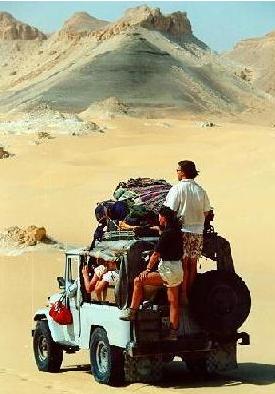
|
| |
|
|

|
| |
|
| Luxor |
|
|
|
Luxor has often been called the worlds greatest open-air museum, as indeed it is and much more. The number and preservation of the monuments in the Luxor area are unparalleled anywhere else in the world. |
|
|
|
Luxor today is a city of some 150,000 people, lies about 670 km south of Cairo. It has an international airport and is accessible from Cairo by buses or trains, which run every day |
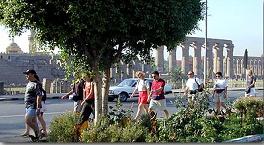 |
| |
|
|
Luxor has been a tourist destination since the beginning of tourism. Even in ancient times, during the late Dynasties of the Greek and Roman periods, the area drew tourists, and has been doing so ever since. Today Luxor is well equipped to accommodate tourists with many luxurious hotels and Nile cruises catering to every taste and offering tourists unforgettable experiences, and in general a tourist industry ready and willing to serve the people from many countries that descend on this area of the Nile Valley every year. |
| |
|
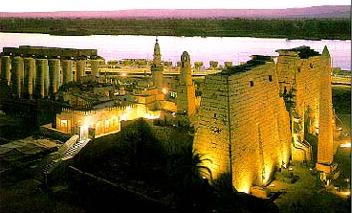
|
| |
|
|
The Nile divides the old Egyptian Capital into two parts: the eastern bank and the western bank. On the eastern bank lie the great Luxor and Karnak temples dedicated to the Sun God Amun Re, while on the western bank in a narrow gorge stretches the necropolis with the famous Valley of the Kings, Valley of the Queens, the tombs of nobles and dignitaries and the great funerary compounds. For an unforgettable experience you can view these awe-inspiring monuments from a hot-air balloon |
| |
|
|
From Luxor you can take Nile cruises south to Aswan, visit the magnificent temples in Kom Ombo, Edfu, Esna, Dendara and Abydos, take tours to the first Oasis in the Western Desert or head to Hurghada on the Red Sea |
| |
|
|

|
| |
|
| Aswan |
| |
|
|
Aswan, Egypt's sunniest southern winter resort and ancient frontier town, lies around 900 km from Cairo and 215km from Luxor. It is one of the most beautiful places in the country with the town located on the east bank and the desert closing in on the Nile. Aswan is truly considered the jewel of the Nile |
| |
|
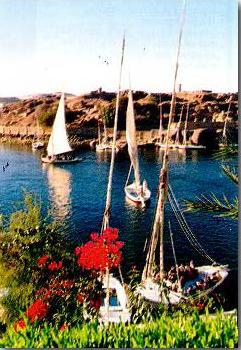
|
Since the period of the Old Kingdom, it was the country’s gate to Africa controlling the trade routes from the south to the north, marking the border between Egypt and Nubia. Hence, it was the harbour and the market of African products: gold, slaves, spices, leathers, ivory, fruits and grains, baskets, mummified and living crocodiles. Even today you’ll find goods, foods and crafts from Aswan’s melting pot cultures sold by a colorful ethnic spectrum in Aswan’s equally colorful “souk” or market place, full of the scent and color of spices, perfumes, scarves and baskets, rarely found anywhere else in Egypt
|
| |
|
|
A perfect place to buy exotic spices, fine alabaster and a wealth of other great souvenirs to take home Much quieter than Luxor, Aswan is small enough to walk around and is graced with the most beautiful setting on the Nile, dotted with islands, covered with shady gardens. |

|
| |
|
|
The two main ones are Elephantine and Kitchener's Islands, which is the site of botanical gardens. |
|
|
|
|

| |
|
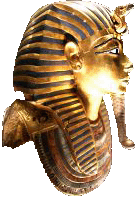
![]()
